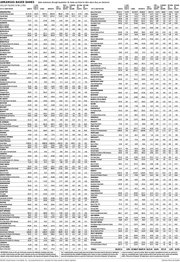Profits and lending are growing at Arkansas-based banks as they rebound from the recession, banking experts say.
Arkansas banks earned almost $572 million in the first nine months last year, up 14 percent from $500 million over the same period of 2012 and up 24 percent from $461million through nine months of 2011.
“The overall earnings for Arkansas banks are better than the national average,” said Julie Stackhouse, senior vice president with the Federal Reserve Bank of St. Louis. “Earnings probably won’t get a lot better, but I sure don’t see it getting a lot worse.”
The other good news is that lending is improving at Arkansas banks, Stackhouse said.
Candace Franks, commissioner of the Arkansas State Bank Department, agreed.
“Loans certainly aren’t improving like they have been in the past, though,”Franks said. “There is still a great need for loans out there. I think any banker in the state would probably say they would love to make some more loans.”
Arkansas banks had almost $37.9 billion in loans through September, up only 8 percent from more than $34.9 billion in loans for the same period in 2009, the year the recession ended.
It’s difficult to determine where the loans are being made, Stackhouse said, because some of the more active Arkansas banks have branches outside the state.
Conway-based Centennial Bank has branches in Florida and Alabama, as well as Arkansas. Little Rock-based Bank of the Ozarks has offices outside the state in Georgia, North Carolina, Texas,Florida, Alabama, South Carolina and New York.
Arvest Bank in Fayetteville and Simmons First National in Pine Bluff also have branches outside Arkansas.
“There is definitely some lending going on, although I can’t tell you if it’s in Arkansas or Florida or Georgia,” Stackhouse said. “Some banks are showing grow thin commercial and industrial loans and in commercial real estate loans.”
The biggest banks in the state have the highest total of nonperforming loans.
Arvest Bank had $237 million in nonperforming loans through September, 2.9 percent of its total loans. Bank of the Ozarks had $127 million in nonperforming loans, 3.8 percent of its total loans. Centennial Bank had $74 million in nonperforming loans, 2.7 percent of its total loans.
Those levels of nonperforming loans are above the state average of 2.3 percent of total loans, but still considerably lower than many of the troubled banks in the state.
Through September, Arkansas banks had $878 million in nonperforming loans, the lowest nine-month total since 2009.
A few banks still have a high percentage of problem loans, Stackhouse said.
“They are coming down but on average they are still a little bit higher [than the average],” Stackhouse said.
One Bank & Trust of Little Rock has $19.7 million in nonperforming loans, but that’s 8.1 percent of its total loans, the highest percentage in the state. Allied Bank of Mulberry also has 8.1 percent of its total loans that are nonperforming.
Problem loans at troubled banks nationally will probably resolve over the next few years, Stackhouse said.
“We have seen probably most of the bank failures,” Stackhouse said. “There will still be some but we’re talking in the 20-ish range a year instead of 100 a year. So it’s more likely, because conditions have stabilized, that the banks that have been struggling will look for buyers.”
She gave the example of Little Rock-based Metropolitan National Bank, whose parent company filed for bankruptcy last year. Metropolitan was sold to Simmons First National last year.
Small banks in rural areas are facing many challenges, particularly with the costs of complying with new federal regulations, said Franks, who will begin serving in May as chairman of the national Conference of State Bank Supervisors.
“Those institutions that have survived for the past five or six years have [proved] they can compete,” Franks said. “But I think long-term, it will be more expensive to comply with the regulations. It’s also hard to attract the kind of employees you need in rural areas to staff your institutions with the kind of challenges they need to keep up with those regulations.”
Some banks in rural areas also are facing generational changes, Franks said. Sometimes relatives aren’t interested in returning home to work in the bank, Franks said.
“So I think you’re going to see some sales and consolidation because of that,” Franks said. “And I think that it will be a challenge to find buyers.”
Business, Pages 61 on 01/12/2014

